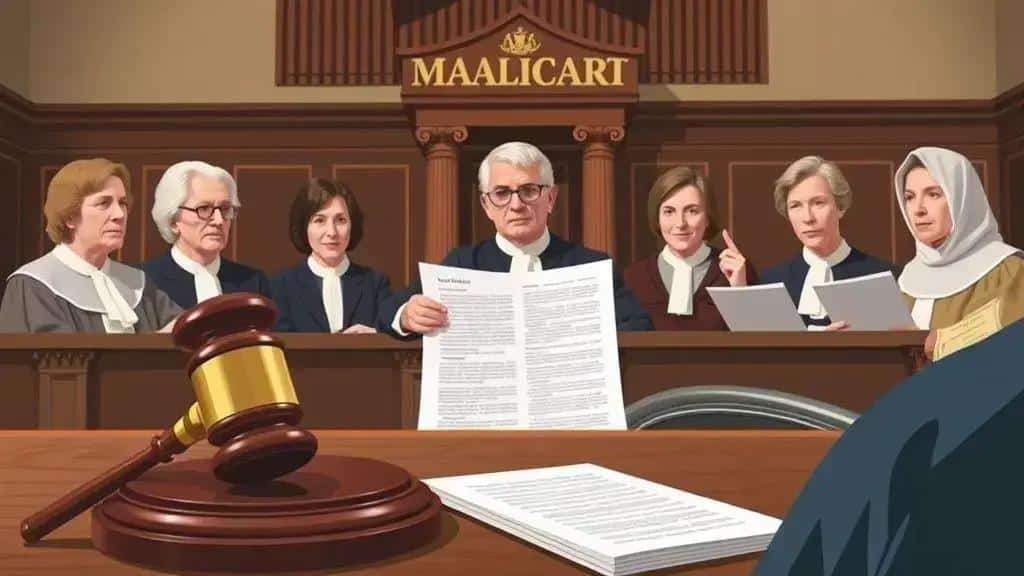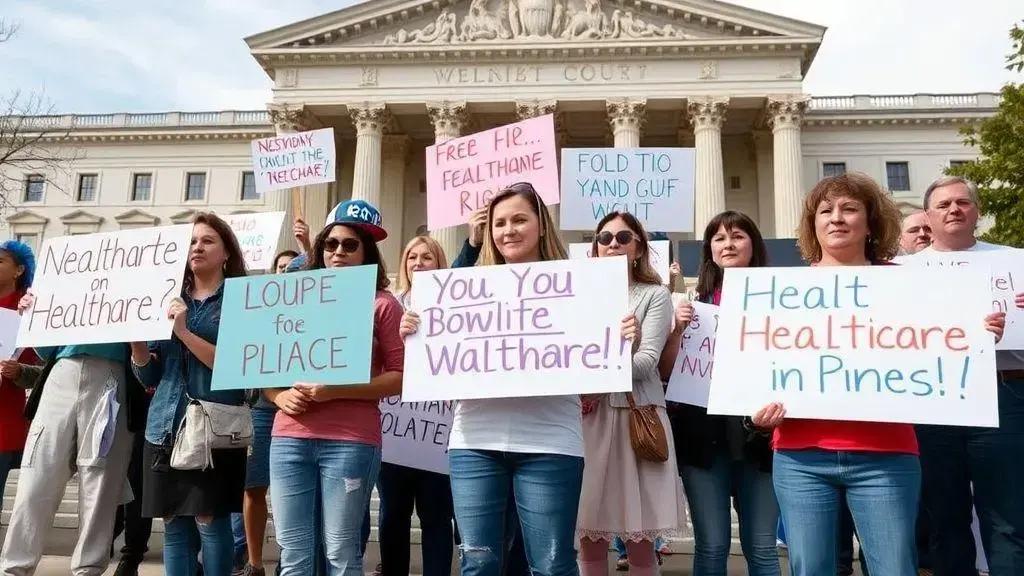Supreme Court blocks Trump’s ‘Big Beautiful Bill’ Medicaid cuts

The Supreme Court blocks Trump’s “Big Beautiful Bill” Medicaid cuts, significantly impacting healthcare funding and access for millions of low-income Americans, while spurring public protests and redefining political debates around healthcare equity.
The Supreme Court blocks Trump’s ‘Big Beautiful Bill’ Medicaid cuts, a pivotal moment in healthcare policy. How does this ruling affect millions of Americans? Let’s dive into the consequences and reactions.
Understanding the Medicaid cuts proposed by Trump
Understanding the Medicaid cuts proposed by Trump is essential for grasping the current healthcare landscape. These cuts aimed to reshape funding and access, generating widespread debate.
What are the Proposed Cuts?
The proposed changes sought to significantly reduce federal spending on Medicaid. This program provides critical health coverage for low-income individuals, including families and the elderly.
Key Aspects of the Cuts
- Reduction in funding to states, impacting services.
- Potential increase in premiums and out-of-pocket costs for recipients.
- Limitations on eligibility, especially for vulnerable populations.
- Greater flexibility for states to manage their Medicaid programs.
These proposed cuts raised concerns about health equity and access. Advocates feared that reducing funds would mean fewer services for those who need them most. The impact on families could be profound, with many losing essential healthcare coverage.
Moreover, states would face tough choices if these cuts were implemented. They might have to make difficult decisions about which services to maintain or reduce, leading to varying outcomes across the country. Understanding these potential changes is crucial for anyone who relies on Medicaid.
Key arguments in the Supreme Court’s ruling

Understanding the key arguments in the Supreme Court’s ruling is vital for grasping the decision’s impact. The court’s ruling addresses significant aspects of health policy, especially regarding Medicaid funding and state rights.
Major Arguments Presented
The Supreme Court heard a range of arguments that reflected differing views on healthcare rights. Proponents of the ruling emphasized the importance of federal regulations in maintaining consistent care across states. They argued that establishing a baseline for Medicaid is essential for ensuring that vulnerable populations receive adequate healthcare.
Citing Legal Precedents
Opponents of the ruling raised concerns about state autonomy. They contended that states should have the power to manage their Medicaid programs based on local needs. This perspective highlighted cases where states successfully adjusted their healthcare models to better serve their communities.
- Legal obligations to provide healthcare.
- The importance of federal oversight.
- State sovereignty in healthcare decisions.
- Potential consequences of reduced funding.
Furthermore, the complexity of healthcare laws means that each argument has far-reaching implications. The dialogue around this ruling showcases a tension between federal standards and state flexibility. These discussions reveal deep-seated beliefs about the role of government in providing essential services.
Overall, the arguments made in the Supreme Court highlight a critical debate about access, rights, and responsibilities in healthcare. By dissecting these arguments, we can better understand the judicial system’s influence on health policy.
Potential impacts on states and the healthcare system
The potential impacts on states and the healthcare system resulting from the recent Supreme Court ruling on Medicaid are significant. Understanding these impacts helps illustrate the broader implications for both healthcare access and state governance.
Implications for State Budgets
States are responsible for administering Medicaid, and any cuts can directly affect their budgets. If federal funding decreases, states may face difficult choices. They could reduce benefits or raise taxes to fill the gap created by lost funds. This situation puts pressure on local governments to balance fiscal responsibility with the need to provide care.
Healthcare Access for Individuals
The cuts may also lead to reduced access to healthcare for many individuals. Vulnerable populations, such as low-income families, the elderly, and individuals with disabilities, could suffer the most. With fewer resources, hospitals and clinics may need to limit services or close altogether, creating a gap in care.
- Reduced services available to patients.
- Increased waiting times for medical assistance.
- Higher healthcare costs for families.
- Potential rise in uninsured rates.
Moreover, states might have different strategies to cope with these changes, leading to uneven healthcare access across the country. Some states may innovate and find ways to maintain care despite funding cuts, while others may struggle to offer basic healthcare services.
Overall, the potential impacts of this ruling extend beyond immediate funding concerns. They encompass long-term effects on healthcare quality and equity throughout the United States. Understanding these dynamics is crucial for predicting how healthcare will evolve in response to the ruling.
Public response and political implications

The public response to the Supreme Court ruling has been diverse and intense. Many individuals and advocacy groups have voiced their opinions, reflecting a wide range of perspectives on the implications for healthcare and social justice.
Protests and Advocacy
Following the ruling, numerous protests erupted across the country. Activists strongly opposed the cuts, arguing that they disproportionately affect the most vulnerable populations. Many organizations, including healthcare advocates and civil rights groups, mobilized to raise awareness about the potential consequences of reduced Medicaid funding.
Political Ramifications
The political implications of the ruling are substantial. Many lawmakers are responding to their constituents’ concerns regarding healthcare access. The debate has reinvigorated discussions about healthcare reform, positioning it as a key issue in upcoming elections.
- Increased scrutiny of healthcare policies.
- Potential shifts in voter priorities.
- Heightened competition among political candidates.
- Calls for more equitable healthcare solutions.
This ruling may redefine party platforms as candidates align themselves with public sentiment about healthcare access. The outcome could influence not just one election cycle but several, as voters increasingly demand accountability and fairness in healthcare policies.
Overall, the interaction between public opinion and political actions illustrates a vibrant democracy engaged in crucial discussions about health and society. The outcome of these discussions will likely shape the future of the healthcare system in America.
The ruling regarding Medicaid cuts has sparked important discussions across the country. It highlights the need for balance between state autonomy and ensuring that all Americans have access to healthcare. The public’s strong reaction, along with the political ramifications, shows that healthcare will remain a central issue. As we move forward, it will be crucial for activists, lawmakers, and citizens to work together to secure a fair and accessible healthcare system for everyone.
FAQ – Frequently Asked Questions about Medicaid Cuts and the Supreme Court Ruling
What was the main focus of the Supreme Court ruling on Medicaid?
The ruling primarily focused on limiting federal funding for Medicaid, affecting how states manage healthcare for low-income populations.
How have the public and advocacy groups reacted to the ruling?
Many citizens and advocacy groups have protested, expressing concern that the cuts will hurt vulnerable populations who rely on Medicaid for essential services.
What are the potential impacts of these cuts on state budgets?
States may face significant budget pressures, possibly leading to reductions in healthcare services or increased taxes to compensate for lost federal funding.
Why is healthcare access a major political issue following the ruling?
The ruling has intensified discussions about healthcare equity, prompting voters to prioritize healthcare access and accountability in upcoming elections.





